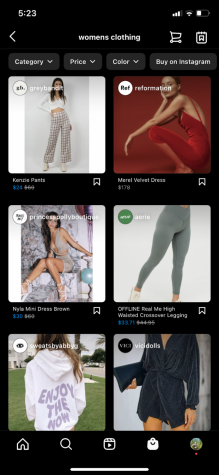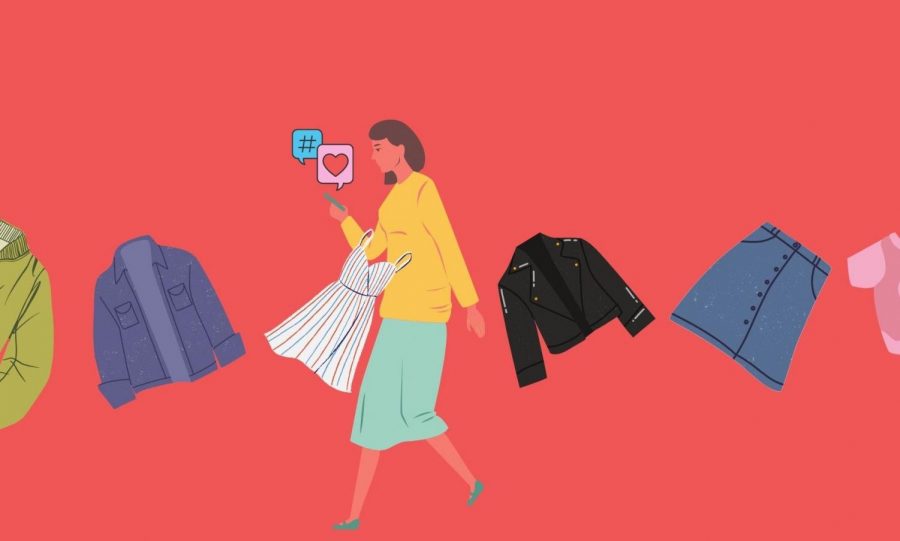Social media fuels fast fashion
December 10, 2021
Our world today is fast-paced; success is defined by crossing the finish line first, the fastest.
The fashion industry is no exception. The toxic quest for speed is reflected in fast fashion through rapid development of ever-changing trends.
Fast fashion, the term used to describe the expeditious and cheap production of clothing to meet the latest fashion trends, has massive ramifications on the environment and exploits garment workers across the globe.
The UN Conference on Trade and Development deemed the fashion industry as the second most polluting industry in the world, behind just the oil industry. Garment workers in Bangladesh are primarily women that make $96 per month—less than a third of what is needed to to live a “decent life with basic facilities.”
Social media only expedites the connection between consumers and products, fueling harmful throw-away culture and overconsumption.
A survey reported in The Standard showed that 10% of the 2,000 consumers that participated throw away an item of clothing once it has been posted to social media on three occasions.
Shein, a popular online clothing retailer, posts 700-1,000 new products to its website per day according to the company’s CEO, Molly Miao. The fast fashion company’s environmental and ethical transgressions have continuously been exposed even despite their lack of transparency regarding their labor practices.
Still, Shein has gained a ton of traction because of social media. With 22.4M followers on Instagram, Shein’s audience is massive. It’s influence only grows by forming paid-partnerships with people like Addison Rae—a mega-influencer on TikTok with over 85M followers.
Fast fashion brand’s heavy reliance on social media for marketing is also supported by the platforms themselves.
Apps like Instagram and Facebook have ways to purchase an item of clothing directly from the post of the influencer who is wearing it.

Social media platforms also target individuals with personalized ads based on data from the infamous algorithm. From what they like, view, and scroll past, these algorithms track users’ every move. Everything is taken into account when promoting certain products.
The culture on Instagram and other social media platforms pressure users to present the “best” version of them.
Instagram is not an accurate representation of someone’s actual life, but rather a highlight-reel of their happiest, most fun selves.
This facade of perfection includes how you dress. With the need to present your best self comes the shame in being unable to keep up with the latest trends, including fashion.
“I think there is a lot of pressure [to stay on top of the newest fashion trends]. Trends spread very quickly across social media,” senior Natalie Kozel said.
Before social media, trends were set by fashion companies every season when they debuted their styles on a runway—one that wasn’t streamed in real-time for millions of consumers.
Now, trends are set by the consumers themselves; anyone can be an “influencer.”
“There are so many influencers who promote trends and since they have a large audience, many people are inclined to follow the trends. When all you see are trends, it’s hard not to feel left out,” Kozel said.
As clothing becomes increasingly viewed as disposable, speedy trend cycles continue to be encouraged. While fashion used to revolve around only the four seasons, there are now 52 micro-seasons in a year.
It is essential for consumers to recognize the toxic trend cycles that social media promotes and make changes to the way they shop.
“There are lots of times where I see something on social media that I’ll obsess over it and think it is super cute when in reality I know it is something that I would only wear once or twice,” Kozel said. “Recently, I have tried to stay away from buying those types of clothes and focus more on things that I could continue to wear every day.”
However, social media can also be used to bring awareness to conscious shopping and encourage the development of a personal style—a style cultivated to you and that doesn’t change with the trends.
TikTok influencer Erika Taylor (@erikatxylor) uses her platform of 26.4K followers to educate people about the danger of the fast fashion industry and advocate for sustainable consumerism.
The best part of ditching fast fashion has been “breaking away from mainstream fashion trends and being my own person,” she said.
“I believe that most fast fashion brands hook their consumers in and create sort of a cult following, breaking away from that hold has resulted in the development of my own unique style.”
While social media can contribute to speedy trend cycles and quicker consumer-product connections, with influencers like Taylor, it can also expedite the spread of valuable information about the fashion industry.
“With the rise of influencers and how much of a platform they have, I’ve had more immediate access to knowledge about the harm of fast fashion,” junior Sheila Falls said. “The impact of style and trends have also given young people, including myself, more motivation to thrift and engage with other sustainable practices.”







